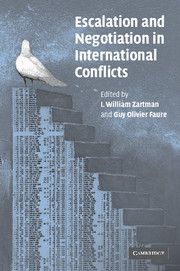Book contents
- Frontmatter
- Contents
- Contributors
- PART I Introduction
- PART II Escalation Forms and Outcomes
- 2 Deadlocks in Negotiation Dynamics
- 3 Deterrence, Escalation, and Negotiation
- 4 Quantitative Models for Armament Escalation and Negotiations
- 5 Entrapment in International Negotiations
- 6 The Role of Vengeance in Conflict Escalation
- PART III Negotiating out of Escalation
- PART IV Conclusion
- Index
- About the Processes of International Negotiation (PIN) Network at the International Institute for Applied Systems Analysis (IIASA)
4 - Quantitative Models for Armament Escalation and Negotiations
Published online by Cambridge University Press: 10 October 2009
- Frontmatter
- Contents
- Contributors
- PART I Introduction
- PART II Escalation Forms and Outcomes
- 2 Deadlocks in Negotiation Dynamics
- 3 Deterrence, Escalation, and Negotiation
- 4 Quantitative Models for Armament Escalation and Negotiations
- 5 Entrapment in International Negotiations
- 6 The Role of Vengeance in Conflict Escalation
- PART III Negotiating out of Escalation
- PART IV Conclusion
- Index
- About the Processes of International Negotiation (PIN) Network at the International Institute for Applied Systems Analysis (IIASA)
Summary
Introduction
Any inquiry into escalation and negotiation in an international context must pay special attention to arms races and their inherent tendency to escalate. Since these phenomena deal with quantities – numbers of ballistic missiles, aircraft, tanks, troops, etc. – it is natural that their scientific treatment includes quantitative analysis. On the other hand, arms races and escalation depend fundamentally on international negotiations, and international relations in general, so that the qualitative methodological tools of political science are also appropriate. The published literature on international negotiation and escalation contains considerable quantitative work on arms races as such, but little quantitative work on negotiations about such races. Thus, it is not surprising that very little quantitative work addresses both subjects at the same time. It is the purpose of this chapter to develop some new ideas on this and to identify directions for future research.
Richardson (1939, 1960) was the first to describe arms races quantitatively and phenomenologically using a system of coupled linear differential equations. His work was brought to a wider audience by the well-known review article of Rapoport and Lewis (1957), which unleashed a veritable avalanche of arms-race research, including both formal theory and empirical analysis. The wealth of theoretical and empirical studies of arms races has been well documented in bibliographies (Cioffi-Revilla 1979) and literature reviews (Busch 1970; Intriligator 1976, 1982; Moll and Luebbert 1980; Avenhaus and Fichtner 1984).
- Type
- Chapter
- Information
- Escalation and Negotiation in International Conflicts , pp. 81 - 110Publisher: Cambridge University PressPrint publication year: 2005
- 1
- Cited by

